
The Red Cedar River of Wisconsin
The Red Cedar River is a medium-sized warmwater river in the Mississippi River drainage basin of western Wisconsin. It begins its journey in northwestern Wisconsin's Chetek chain of lakes. There, its flow is heavily regulated by dams, creating a series of impoundments. The small Chetek River, along with a profusion of smaller warmwater and coldwater streams, feed the extreme upper reaches of the Red Cedar. In Tainter Lake, near Wheeler, the Hay River joins the Red Cedar's flow. The Hay River is the largest tributary to the Red Cedar, flowing down from Prairie Farm to the west and adding signifiantly to the Red Cedar's water volume. Below Tainter, there is a short and fairly featureless run of three miles to Lake Menomin. The Menomin Dam, below Lake Menomin, is the last barrier before the Red Cedar finally flows into the much larger Chippewa River near Dunnville. The final 17.5 miles of river are the most ecologically diverse and interesting part of the river. The Red Cedar's mouth at the Chippewa is located in a fairly pristine area, and forms a travel highway for both riverbourne people and fish.

The forested complex of dams, resort communities, and reservoirs near Barron is a popular destination for vacationers from Wisconsin and elsewhere. Here, the Red Cedar begins its journey. Rice Lake, Chetek Lake, Balsam Lake, and Red Cedar Lake all gather portions of its headwaters. These reservoirs are mostly popular for panfish fishing, water-skiing, and sightseeing. They are well-known by local anglers for the "fish cribs" which have been sunk at various locations around the lakes to attract panfish for the local anglers.The locations of these fish-attracting structures are often closely guarded secrets, handed down from generation to generation. The principle panfish of interest are bluegill and black crappie. Roughfishing is rare, as is shoreline access to the river, as the land is mostly private. Those who venture out onto the impoundments are often impressed with the muskellunge and panfish fishing. Deeper basins contain Northern Cisco. Bowfin and largemouth bass are a common catch. Large white suckers may be found in this section of the river, and are available to bank fishermen at road crossings.
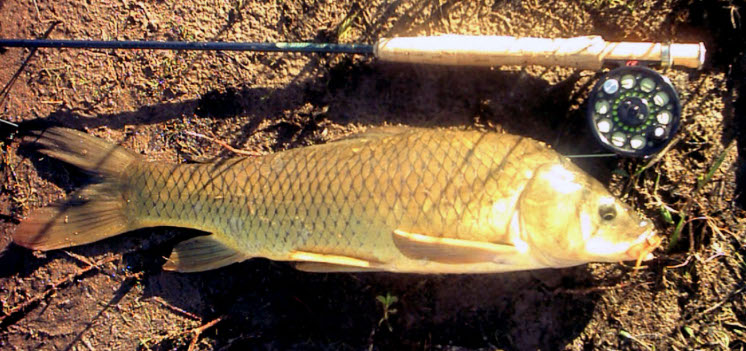
The middle portion of the Red Cedar bisects southern Barron and northern Dunn County. It runs a torturous, winding course through a mixed agricultural and forested region. Oxbows and weedy backwaters are everywhere, and many of these connected off-channel habitats play host to a large muskellunge or two. A few scattered boat launches and bridge crossings provide the only access. This is a sluggish, low-gradient section of river, perfect for a leisurely canoe or kayak trip - but the slow current and extremely meandered shape make for a long and slow float, so leave plenty of time to make your take-out spot. Silver and Golden redhorse appear in the fish fauna, along with freshwater drum and the occasional white bass, but the dominant fish species are smallmouth bass, and muskellunge. A sizeable carp population can often be targeted by sight in the clear, slow water. The river then flows southward through Dunn county, eventually pouring over a linked pair of working hydroelectric dams at Tainter Lake and Lake Menomin. These two impoundments trap the runoff water from a large agricultural and residential area, concentrating fertilizers and causing severe pollution. Both lakes have very high levels of phosphorus and nitrogen, which is a recipe for disaster during the long northern summers. Microscopic algae reproduce exponentially under these conditions, turning both lakes into a disgusting soup the color of canned peas. Mats of foul-smelling scum cover the surface and choke out any aquatic vegetation that might try to grow here.
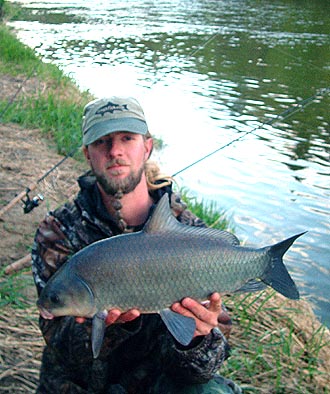
Below the Menomin Dam begins a classic 17.5-mile stretch of water that roughfishers simply call the Lower Red Cedar. It begins at the dam itself, right in the middle of the town of Menomonie (Not to be confused with the town called Menominee - notice the spelling difference. Menominee is a town on the Menominee River near Green Bay. Menomonie is a town on lake Menomin near Hudson). The lower Red Cedar is a higher-gradient stream with frequent rapids and riffles. It flows into the extreme northern fringe of the driftless region of limestone bluffs and trout streams. This section of river is diverse. It's the only river I know of where a person can catch a brook trout and a bowfin on successive casts. Access is plentiful, beginning at the Menomin Dam. Below the dam, the Junction and Stokke trails lead downstream along the river's west bank, allowing access to three sets of riffles and pools from the old rail bridge down to the Hudson Street bridge. At Hudson street, there is a trail parking area on the west bank and a boat launch on the east bank. Farther downstream is Galloway Creek Mouth, The Devil's Punchbowl, and Tripp Falls Ravine. There is also access at the public boat launches in Downsville and Dunnville, plus easy access to the mouth on Dunnville Road. The Red Cedar State Trail is a bicycle path that follows the old railroad grade along the river. This trail can be used to hike into more remote areas along the river. This includes several trail bridges that cross the river as well as some of the best oxbow habitat on the river.
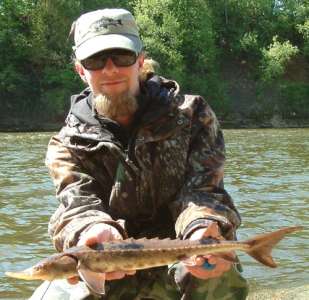
The Menomin Dam completely blocks fish passage, preventing migrating fish from reaching the upper parts of the river. In the spring, giant lake sturgeon swim up the Red Cedar to this dam, where they are prevented from spawning by the concrete wall. These fish are so old that they probably started making this migration before the dam was built in 1958. The water runs quite clear in the springtime and into the early summer. In addition to the lake sturgeon, redhorse of five different species (silver, golden, river, greater, and shorthead) are abundant. Smallmouth buffalo and carp are common. Quillback and river carpsuckers are very abundant, often seen feeding in the side channels and connected backwaters in large, tight schools. Good luck approaching them, though - it takes a true river ninja to bank a quilly on the Red Cedar. Infrequent flooding can strand fish in the shallow backwaters near the river, and in some cases they fluorish there. Bigmouth buffalo are one of the most common species to be found in these isolated riverside hotspots. These oxbows can produce world-class bigmouth buffalo fishing if they are far enough down the trail from the access to prevent bowfishers from killing them all.
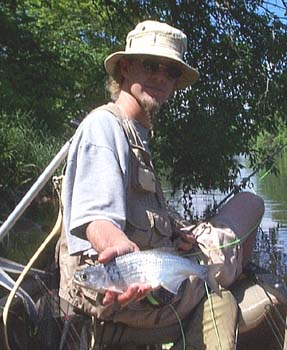
Mooneye are ubiquitous in the lower Red Cedar, often rising to the prolific insect hatches. Scattered mooneye can be caught in the depths of the main channel by drifting a nightcrawler. They can also be caught by running a big, bushy dry fly along any of the many deep, rocky banks you'll find armoring the outside bends. There are usually a couple of mooneyes hanging out under the bridges. Punch a roll cast up under the span and you might get a nice surprise. Brook and brown trout will appear in the river seasonally, often showing up in the main river in March and April, then retreating to the coldwater tributaries once the water warms. Trout season is usually closed while the trout are in the river. Hogsuckers are uncommon compared to other nearby rivers, but the ones that are there run large. The Red Cedar also is home to a population of blue suckers, some of which are big for midwestern populations. Blue suckers have been captured up to 34 inches long. . Shovelnose sturgeon were once an important part of the fish comunity but have largely disappeared from the Red Cedar in recent decades. Game fishes include yellow perch, smallmouth bass, and walleye - but you can catch those species anywhere. Overall, it's not unusual to put ten or twelve large species on the bank in a single day, which is an extraordinary tally for any river in North America.
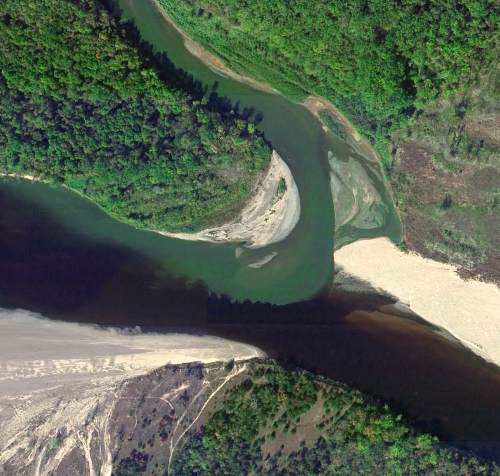
Unfortunately, something this great cannot last forever. In the case of the Red Cedar, that means the fun ends abruptly in July each year, when the pollution-concentrating Menomin and Tainter lake dams spew sickly green algae-choked lake water into the river and shut the fishing down completely. Sure, you can still finagle a sick-looking carp or walleye from the filthy green water, and gizzard shad seem to fill the river from bank to bank - but fishing for anything else is often an exercise in futility midsummer. The river becomes an opaque mess below the dam. The Red Cedar has few large tributaries, so the polluted water remains undiluted all the way until it empties into the Chippewa. The photo above shows the confluence in midsummer, with the pea-soup water from the Red Cedar joining the dark and clear waters of the Chip. The green coloration is noticeable all the way to the Mississippi. Hopefully, future projects will both fix the pollution problems in the watershed and allow fish passage through Menomin and Tainter lakes. Hopefully, that will happen before the giant sturgeon of the Red Cedar die of old age.
Note: At the time of this writing, several species indiginous to the Red Cedar (including, but not limited to: blue sucker, river redhorse, crystal darter, and black buffalo) are completely protected and should not be targeted by anglers. Be sure to familiarize yourself with Wisconsin's Threatened and Endangered Species List and all other applicable laws before your trip to the Red Cedar. Violating any of these laws, even inadvertantly, can result in fines up to $5,000 and the loss of hunting and fishing privileges.
Species Covered:
- Bass, Largemouth
- Bass, Smallmouth
- Bass, White
- Bowfin, Eyetail
- Buffalo, Bigmouth
- Buffalo, Smallmouth
- Carp, Common
- Carpsucker, Quillback
- Carpsucker, River
- Cisco, Northern (Tullibee)
- Crappie, Black
- Drum, Freshwater
- Muskellunge
- Perch, Yellow
- Redhorse, Golden
- Redhorse, Greater
- Redhorse, River
- Redhorse, Shorthead
- Redhorse, Silver
- Shad, Gizzard
- Sucker, Northern Hog
- Sucker, White
- Trout, Brook
- Trout, Brown
- Walleye
 Powered
Powered
Comments
TonyS
Wed, 03/19/2014 - 19:54
Permalink
Nice write up! LRC for life
Nice write up!
LRC for life! (OR at least from April-June, before it turns to pea soup...) I should note that one CAN catch huge Turtles (Snapper and Softshell) from the green mess but even Bowfin seem sparse at that time. Either way, it is a great river to fish (in spring)
andy
Thu, 03/20/2014 - 00:24
Permalink
love the lrc!
Jason E.
Thu, 03/20/2014 - 15:24
Permalink
Great write-up. I sure don't
Great write-up. I sure don't fish that river as much as I used to or as much as I would like. LOTS of variety there. One day (probably more than 10 years ago), I hunted for access points north of Menomonee and found only one. Hopefully the access is a bit easier now.
zippyFX
Thu, 03/20/2014 - 19:04
Permalink
Great report!
Great report!
Eli
Thu, 03/20/2014 - 19:48
Permalink
Sounds like a great piece of
Sounds like a great piece of water.
Hopefully they'll regulate the algea problem out of existance in the not too distant future, and it will become a good place to fish year-round.
Eli
Graceclaw
Fri, 09/11/2015 - 12:56
Permalink
Thank you LRC
I had the priveledge of fishing it this summer, and I will forever be indebted to it.